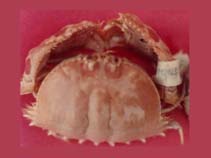Calappa philargius (Linnaeus, 1758)
Spectacled box crabWarning: DOMDocument::load(): SSL operation failed with code 1. OpenSSL Error messages: error:140770FC:SSL routines:SSL23_GET_SERVER_HELLO:unknown protocol in C:\Apache24\htdocs\includes\SpeciesSummary.lib.php on line 1236
Warning: DOMDocument::load(): Failed to enable crypto in C:\Apache24\htdocs\includes\SpeciesSummary.lib.php on line 1236
Warning: DOMDocument::load(https://sealifebase.nrm.se/webservice/AquaMaps/getAMap.php?genus=Calappa&species=philargius): failed to open stream: operation failed in C:\Apache24\htdocs\includes\SpeciesSummary.lib.php on line 1236
Warning: DOMDocument::load(): I/O warning : failed to load external entity "https://sealifebase.nrm.se/webservice/AquaMaps/getAMap.php?genus=Calappa&species=philargius" in C:\Apache24\htdocs\includes\SpeciesSummary.lib.php on line 1236
Classification / Names Common names | Synonyms | CoL | ITIS | WoRMS
| Decapoda | Calappidae
Environment: milieu / climate zone / depth range / distribution range Οικολογία
; εύρος βάθους 0 - 100 m (Ref. 343). Tropical
Κατανομή Χώρες | Περιοχές FAO | Οικοσυστήματα | Παρουσίες | Εισαγωγές
Indo-Pacific.
Length at first maturity / Μέγεθος / Βάρος / Age
Maturity: Lm ? range ? - ? cm Max length : 12.0 cm CW αρσενικό/απροσδιόριστο; (Ref. 343)
Short description Μορφολογία
The two thick and strong chelipeds are similar in size. The movable fingers differ in forms and functions. Body is brownish-red, with distinct dark red spots on the chelae. A dark red ring is present around the eyes. Anterolateral margin of the carapace granulated. Posterolateral and posterior margins bear around 15 shape teeth.
Minimum depth from Ref. 99823. Subtidal (Ref. 106854). Occurs in sandy to slightly muddy substrates. Subtropical and tropical climates (Ref. 343). During the day, it buries itself, leaving only the eyes above the substratum. Forages as night. Feeds mainy on molluscs (Ref. 125532).
Life cycle and mating behavior Γεννητική Ωρίμανση | Αναπαραγωγή | Γεννοβολία | Αβγά | Γονιμότητα | Προνύμφες
Members of the order Decapoda are mostly gonochoric. Mating behavior: Precopulatory courtship ritual is common (through olfactory and tactile cues); usually indirect sperm transfer.
Main reference
Αναφορές | Συντονιστής | Συνεργάτες
Ng, P.K.L. 1998. (Ref. 343)
IUCN Red List Status (Ref. 130435)
CITES status (Ref. 108899)
Not Evaluated
CMS (Ref. 116361)
Not Evaluated
Threat to humans
Harmless
Human uses
| FishSource |
Εργαλεία
Περισσότερες πληροφορίες
Διαδικτυακές πηγές
BHL | BOLD Systems | CISTI | DiscoverLife | FAO(Publication : search) | Fishipedia | GenBank (genome, nucleotide) | GloBI | Gomexsi | Google Books | Google Scholar | Google | PubMed | Δέντρο Ζωής | Wikipedia (Go, αναζήτηση) | Zoological Record
Estimates based on models
Preferred temperature
(Ref. 115969): 22.3 - 29.1, mean 28 (based on 1902 cells).
Price category
(Ref. 80766):
Unknown.



